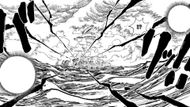Ever since One Piece introduced the mysterious figure of Joy Boy, fans have speculated endlessly about who he really was, what race he belonged to, and why his legacy continues to shake the foundations of the world 800 years later.
The Void Century, the Great Kingdom, and the promises Joy Boy made have all been shrouded in secrecy, leaving only fragments of his identity behind through poneglyphs, legends, and the whispers of those who remember him.
But after the God Valley flashback, coupled with Oda’s long-running hints, the answer seems closer than ever. The evidence points to one clear conclusion: Joy Boy was a Buccaneer, and One Piece has been laying this groundwork all along.

The Buccaneers were introduced to us through Bartholomew Kuma’s tragic backstory. In One Piece chapter 1095, Kuma’s father explained that the legend of Nika, the Sun God who brings freedom and laughter, had been passed down through Buccaneer folklore for generations. This detail was quietly massive.
The Gorosei themselves, back in chapter 1037, admitted that the Nika fruit’s true name was erased from history. To them, Nika was just a forgotten myth. Yet for the Buccaneers, the story of Nika remained alive, a cultural touchstone passed on despite World Government suppression.
Why would this be the case unless Joy Boy himself, hailed as Nika by those who knew him, was one of their own? The Buccaneers’ size and strength also align perfectly with the legends surrounding Joy Boy.
They are not as colossal as giants, but they tower over normal humans, large enough to wield immense power and inspire awe, yet small enough to interact with humans and fishmen as equals. That “in-between” size makes sense of a longstanding mystery: the giant straw hat hidden in Imu’s chamber.
The crime of the Buccaneers and Joy Boy’s legacy in One Piece

Another crucial clue lies in the fact that the World Government deemed the Buccaneers guilty of a crime so severe that they hunted the entire race nearly to extinction. Kuma’s father alluded to this “crime” without elaborating, but it seems increasingly likely that it was tied to Joy Boy himself.
If Joy Boy were a Buccaneer, and he wielded the Nika fruit against the First Twenty Kingdoms during the Void Century, then his very existence would be branded as a threat to their new world order. By eradicating his race, the World Government wasn’t just punishing an enemy; they were trying to erase the bloodline and the memory of the original liberator.
It also reframes the story of the Void Century as a racial war, not just a political one. The Lunarians, Buccaneers, Minks, Fishmen, and other non-human tribes all suffered persecution, and it now seems likely that they fought alongside Joy Boy in his rebellion against the ancestors of the Celestial Dragons.
The recent God Valley flashback in One Piece adds new weight to this theory. God Valley revealed the clash between Rocks D. Xebec’s pirates, the Roger Pirates, and the World Government, with the Buccaneer race at the center of it all. Kuma’s own suffering is directly tied to this event, showing that the World Government’s brutality against Buccaneers was systematic and deeply rooted.
Final thoughts
Oda has been hinting at it all along, but God Valley makes it clear: Joy Boy’s true race has always been tied to the Buccaneers, the nearly extinct people who carried his legend even as the world tried to erase it.
In the end, it won’t matter that Luffy isn’t a Buccaneer by blood because One Piece has always been about inherited will. And just like Joy Boy before him, Luffy’s laughter, freedom, and unbreakable spirit will light the way to the world’s true dawn.
